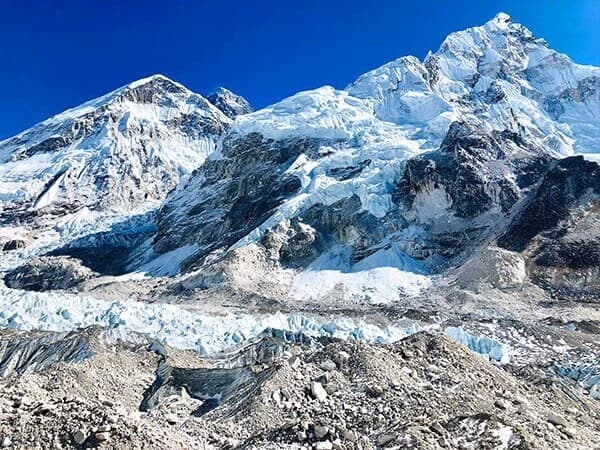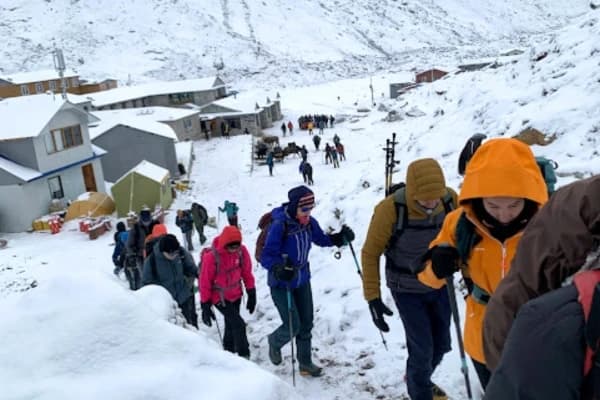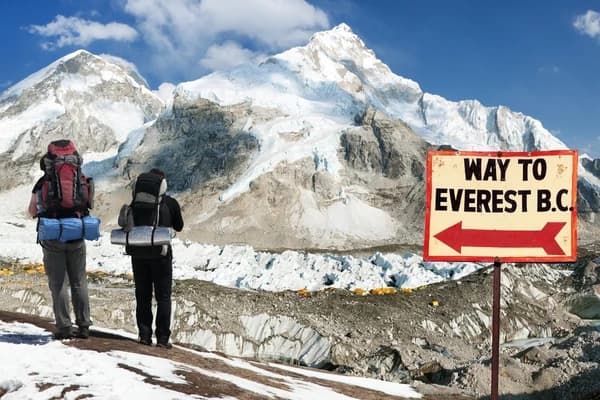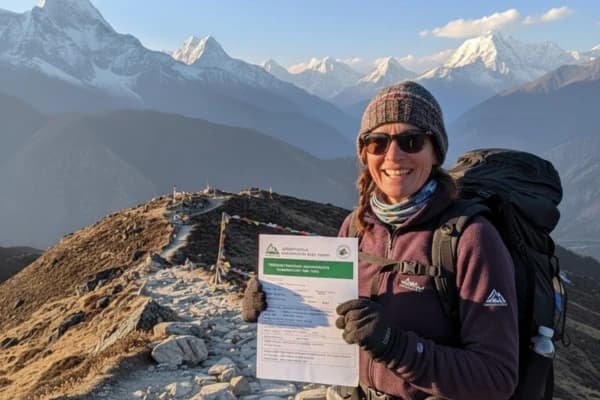The Everest Base Camp Trek is one of the world’s most popular walks, which attracts thousands of trekkers and mountaineers every year. In winter, however, it brings a distinct experience and visual delights for those willing to brave the cold and challenging conditions.
Winter is considered off-season for the EBC Trek. During these months, the trails of Everest are far less crowded compared to the busy autumn and spring seasons. The reduced flow of trekkers allows you to enjoy the rare solitude, authentic experience, and meaningful connection with local communities.
Unlike other seasons, winter brings crisp, clear skies with uninterrupted panoramas of the Himalayas. The snow-covered trails and landscapes also create a serene atmosphere across the Khumbu region.
Having said that, the winter season brings harsh weather and challenging conditions. While the daytime temperature is tolerable, the temperatures in the mornings and nights can often drop below freezing. The trails in the upper sections of the trek can be covered in snow and packed ice, which can be slippery and dangerous. Therefore, this season demands serious preparation and proper gear.
In this article, we’ll take a thorough look at what it’s like to trek to Everest Base Camp in winter. We’ll take a deep dive into topics such as weather, trail conditions, advantages, challenges, accommodation, flights, safety precautions, and packing lists for a winter trek to Everest Base Camp.
Weather and Temperature of the Everest Base Camp Trek in Winter
Winter in the Everest region lasts between December and February. Although weather and temperature during these months vary significantly by altitude, it is generally characterized by cold, dry, and stable conditions.
At lower regions, such as Lukla, Phakding, and Namche Bazaar, the daytime temperatures typically range from 0°C to 10°C. The temperature in mornings and nights often remains close to or below freezing. The weather in the lower stretches stays clear and sunny with relatively low humidity.
In higher elevations, the conditions become relatively harsher, with daytime temperatures hovering around -5°C to 5°C. The mornings and nights are usually extreme, with temperatures dropping as far as -15°C to -25°C. The weather in the upper stretches can change quickly. While most mornings offer clear skies and excellent visibility, the afternoon brings thick cloud cover, frequent snowfall, and strong winds.
Why Choose Winter for the Everest Base Camp Trek?
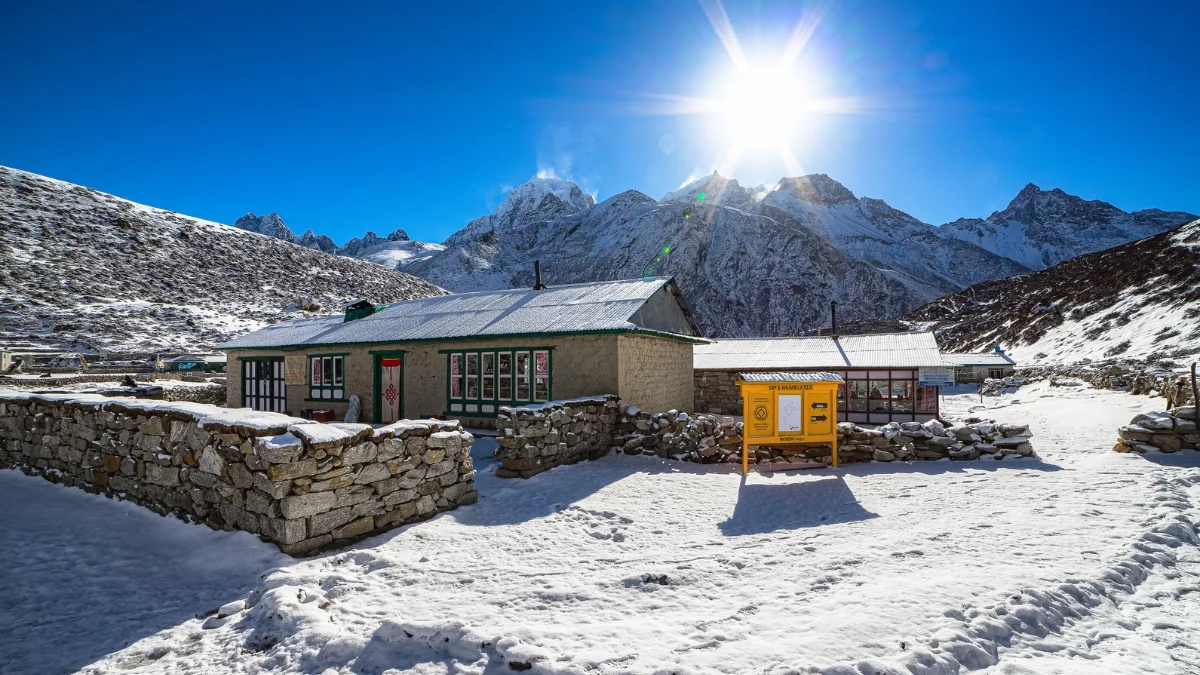
Here are a few advantages of trekking to Everest Base Camp in winter:
Less Crowded Trails
After the peak months of October and November, the trail to Everest Base Camp begins to thin out in the winter season. With only a few seasoned trekkers making their way to the base camp, you’ll get to enjoy the unique experience of stillness and solitude that’s hard to find in any other season.
You’ll have more relaxed and unhurried moments at famous viewpoints and iconic spots without the usual rush. The reduced flow of the trekkers also allows for a more personal and meaningful connection, as the teahouse owners and shopkeepers have more time to chat and share stories, enhancing your cultural experience.
Start your Everest Base Camp trek in November for fewer crowds and unforgettable memories!
To Celebrate Christmas and New Year at Everest Base Camp
Our winter season is from December to February. One of the best reasons to do the EBC trek in winter is to celebrate Christmas and New Year at Everest Base Camp. It is worthy and a lifetime memory to celebrate the Christmas and New Year festivals with your family, friends, and colleagues.
Crystal-Clear Mountain Views
Winter is one of the best times to experience unobstructed views of the mountains in the Everest region. The cold, dry winter air reduces cloud cover and humidity, allowing the snow-capped peaks to stand out sharply against the clear blue skies. We always say that spring (March to May) and autunm (September to November) are the best time to do a trek to Everest Base Camp.
However, dispite the cold temperature, the winter season offers the best sunset views over the high mountains. The sunset views with golden color from Kalapather over the Mount Everest and it's surrounding is magnificent.
Although the afternoon weather can change unexpectedly, the winter mornings usually bring stable weather and excellent visibility. For photographers and mountain lovers, this is the perfect time to enjoy the mountains in all their glory as they’re blanketed in fresh snow.
Mesmerizing Snow-Covered Landscapes
Winter transforms the Everest region into a visual delight with snow-draped trails and villages. At higher elevations, almost everything lies beneath the coat of snow, adding a more pristine and striking impression to the region.
This not only adds to the visual appeal but also makes the journey more adventurous as you navigate the snowy paths.
Better Accommodation
With a reduced number of trekkers, the teahouses in the Everest region remain less busy. It means you have the option to choose a room with better views or one near the dining area.
Unlike peak seasons, the atmosphere in the teahouse is also more relaxed and peaceful. You can stay by the fireplace in the dining area and work on your journals without any distractions. Additionally, you’re likely to get attentive service and minimal wait times for meals during winter.
Wildlife and Nature Encounters
With less human disturbance, birds and animals are more likely to appear along the route or near the villages. If you’re lucky enough, you might encounter a few rare species, including the Himalayan tahr, red panda, pika, and snow leopard, along the trail.
In the forested area, you might spot birds like the Danphe, snow partridge, blood pheasant, snow pigeon, Himalayan griffon, and lammergeier. While the sightings can’t be guaranteed, you’ll get to experience the Khumbu Valley at its quietest.
Planning your next EBC trek? Follow our complete guide for Everest Base Camp Trek and let Nepal Gateway Trekking make your journey safe, exciting, and unforgettable.
Challenges of the Everest Base Camp Trek in Winter
Here are a few challenges of trekking to Everest Base Camp in winter:
Extreme Weather Conditions
One of the biggest challenges of trekking to Everest Base Camp in winter is the extreme temperatures. Although daytime temperatures remain tolerable, the nighttime temperatures can plummet below -20 degrees Celsius.
At higher altitudes, you’ll experience freezing cold, heavy snowfall, and strong winds. Additionally, freezing temperatures increase the risk of hypothermia and frostbite. Therefore, it is critical to pack appropriate clothing and supplies to keep you warm and protected from the harsh weather during winter.
Slippery and Icy Trails
During winter, the trails to Everest Base Camp are often shrouded in thick layers of snow and ice. Sections above Namche Bazaar become slippery and difficult to navigate. While the fresh snow can obscure the trail, older snow hardens into packed ice, demanding extra caution and careful footing.
Although snow-covered trails add difficulty and slow you down, they are manageable with patience and appropriate gear. We highly recommend using trekking poles and crampons/microspikes for safety and balance.
Shorter Daylight Hours
Unlike other seasons, winter experiences reduced daylight lasting around 8 to 10 hours. This results in shorter trekking hours. Additionally, the temperature often drops quickly by late afternoon, making it difficult to walk. At times, you may need to break down longer trekking days into two shorter ones, which can extend the overall length of the trek.
Therefore, you must manage your pace carefully with limited rest hours in winter to ensure you reach your destination on time. We recommend keeping your headlights and spare batteries ready to start your trek before sunrise.
Higher Risk of Altitude Sickness
Regardless of season, altitude sickness is one of the biggest concerns in the Everest Base Camp Trek. However, extreme weather conditions can worsen the symptoms significantly. Cold temperatures can put your body through extreme stress, and shorter daylight hours force trekkers to move quickly without proper rest.
Both of these factors can significantly increase the risk of altitude sickness. Winter treks in the Everest region demand extra patience and altitude awareness. So, plan your itinerary carefully with proper acclimatization days, and revise your itinerary immediately if you notice any symptoms.
Limited Facilities
Due to severe cold and harsh weather, most teahouses and shops in the upper reaches of Everest are closed in winter. In smaller villages, the accommodation can be limited, and menus may offer fewer choices than in the peak seasons. Additionally, other services like hot showers, Wi-Fi, and charging facilities may be scarce or unavailable at higher altitudes.
Therefore, it is critical to mentally prepare yourself for limited conditions while trekking to Everest Base Camp in winter. It is best to carry your favorite snacks, spare batteries, and a high-capacity power bank for your convenience.
Talking about the best time for Everest Base Camp Trek, here you can explore our detailed blogs for proper insights:
Accommodation and Meals in the EBC Trek in Winter
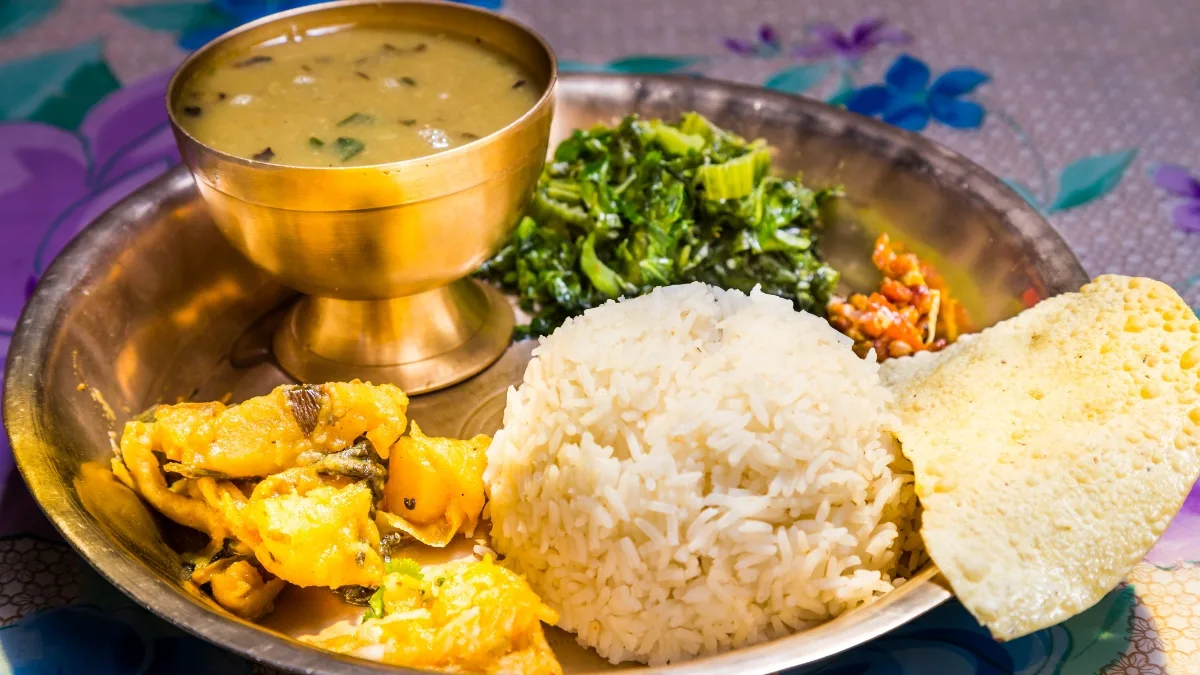
There’s both a good and an ugly side when it comes to winter accommodation in the Everest region. On the positive note, the lodges and teahouses are far less crowded compared to the peak seasons. Therefore, finding a room is rarely an issue during these months. Additionally, you have the luxury to choose a better room, get more personal attention, and quicker services at mealtimes.
The downside, however, is that most teahouses in the upper region are closed during winter, due to extreme weather and reduced flow of trekkers. This means you’ll have limited options to settle in the upper sections.
Usually, heating is only available in the dining area. Therefore, the rooms are often cold. You must carry a warm sleeping bag suitable for sub-zero temperatures to brave the chilly nights. Other facilities such as Wi-Fi, electricity, and hot showers may be limited or unavailable in most teahouses.
Unlike peak seasons, meal availability and variety are also limited in winter due to supply challenges. Most teahouses in the high altitudes only offer staple meals such as Dal Bhat and instant noodles. It is advisable to carry some of your favorite treats and snacks as backup in case of limited food options.
Flying to Lukla in Winter: Delays, Risks, and Alternatives
Regardless of the season, the Tenzing-Hillary Airport in Lukla is infamous for frequent flight delays and cancellations. Although flying into Lukla is the fastest and most comfortable way to start the Everest Base Camp Trek, the flights to this small airstrip face extra challenges during winter.
Winter months often bring unpredictable weather with thick cloud cover, fog, and strong winds. Due to unstable weather and low visibility, a large number of flights to and from Lukla are delayed or cancelled during winter. Although flights are typically scheduled early in the morning when the weather is most stable, you can’t control or guarantee what nature brings.
In the worst conditions, the Lukla flights can be grounded for several days in a row. If not prepared well, this can disrupt your itinerary, cause you to miss international flights, and lead to unexpected accommodation costs while you’re stranded in Lukla. Therefore, you should always have a few buffer days in your schedule to deal with possible delays while trekking to Everest Base Camp.
If you do not want to risk the possible delays or flight cancellations, there are a few alternatives to the Lukla flight. One of the most reliable and convenient ways to reach Lukla is via a helicopter. Although expensive, helicopters are better equipped to operate in bad conditions and bypass sudden weather changes, compared to regular flights.
Another option is to take a jeep ride from Kathmandu to Paiya or Surke and trek to Phakding. The overland option is far cheaper and more reliable than flying to Lukla. However, it is relatively rugged and requires adding a few extra days to your itinerary.
Health and Safety Precautions for Winter Trek to Everest Base Camp
As mentioned, the winter trek to Everest Base Camp poses several challenges. For a safe and successful trek, it is crucial to follow a few health and safety precautions to brave the cold, high-altitude environment.
Proper Acclimatization
No matter the season, acclimatization remains one of the most critical aspects of the Everest Base Camp Trek. However, winter demands more caution than any other season, as the severe cold can significantly exacerbate the symptoms of AMS.
The best way to prevent it is to follow a well-paced itinerary, stay hydrated, and ascend gradually to let your body adapt to the altitude. Consider adding a few days of acclimatization at Namche Bazaar and Dingboche before heading to higher altitudes. If you notice any symptoms, stop ascending immediately and settle in the nearby teahouse or descend to a lower altitude.
Layering and Protection
It is highly crucial to dress in layers and use proper gear to stay protected from the harsh winter conditions. An ideal layering system includes a base layer, an insulating layer, and a waterproof outer shell.
Unlike other seasons, you should protect your head, hands, and feet from the cold winds throughout the trek. On sunny days, the glare from the snow can be intense. Therefore, it is essential to wear UV-protected sunglasses and apply sunscreen regularly. Consider investing in high-quality hiking boots, crampons, and trekking poles to navigate the snowy trails of the Everest region.
Travel Insurance
Compared to other seasons, the winter months bring higher risks of altitude sickness, health issues, accidents, weather delays, and flight cancellations. Therefore, you must buy travel insurance before heading to the Everest Base Camp Trek in winter.
Make sure your insurance policy covers high-altitude trekking (above 5,500 meters), emergency helicopter evacuation, and medical expenses. It is also beneficial to have coverage for trip interruptions and extra accommodation in case of weather delays, especially in Lukla.
Trail Conditions and Weather Monitoring
In case of excessive snow and bad weather, the trails of Everest Base Camp can be challenging and slippery during winter. Therefore, it is crucial to get updates regarding the trail conditions before heading to the mountains. The route in the upper section of the trail can be covered in thick snow and packed ice. You must carry trekking poles and crampons to navigate these sections.
Likewise, the weather in the mountains can change quickly during winter. It often brings freezing temperatures, heavy snowfall, and possible snowstorms. You must regularly monitor the weather forecasts to avoid risky sections and getting stuck in a remote village. If you’re not careful, you can be stranded in Lukla Airport for weeks due to bad weather.
Avoid Alcohol and Smoking
Regardless of the season, you must avoid alcohol and smoking while trekking to Everest Base Camp. Consuming alcohol and tobacco increases dehydration, disrupts sleep, and exacerbates the risk of altitude sickness. Additionally, these substances also lower body temperature and affect heart rate, which can often be dangerous in cold conditions.
Instead, we recommend that you focus on staying hydrated, eating nutritious meals, and getting proper sleep for a safe and successful adventure.
Physical and Mental Preparedness
The winter trek to Everest Base Camp demands both physical and mental preparedness. Compared to other seasons, the winter months bring additional challenges with extreme temperatures, snow-covered trails, and shorter daylight. So, begin your training at least 8 to 10 weeks before the trek. We recommend focusing on building stamina and cardiovascular strength through regular cardio training, strength workouts, and practice hikes.
It is also crucial that you prepare yourself mentally before the trek. Flight cancellations, weather delays, physical strain, and limited facilities can be really frustrating. However, you must remain patient, build a positive mindset, and have a flexible schedule to enjoy the trek despite the challenging winter conditions.
If you are not fully prepared for the trek, you can also choose Everest Helicopter Day Tour.
What to Pack for the EBC Trek in Winter?
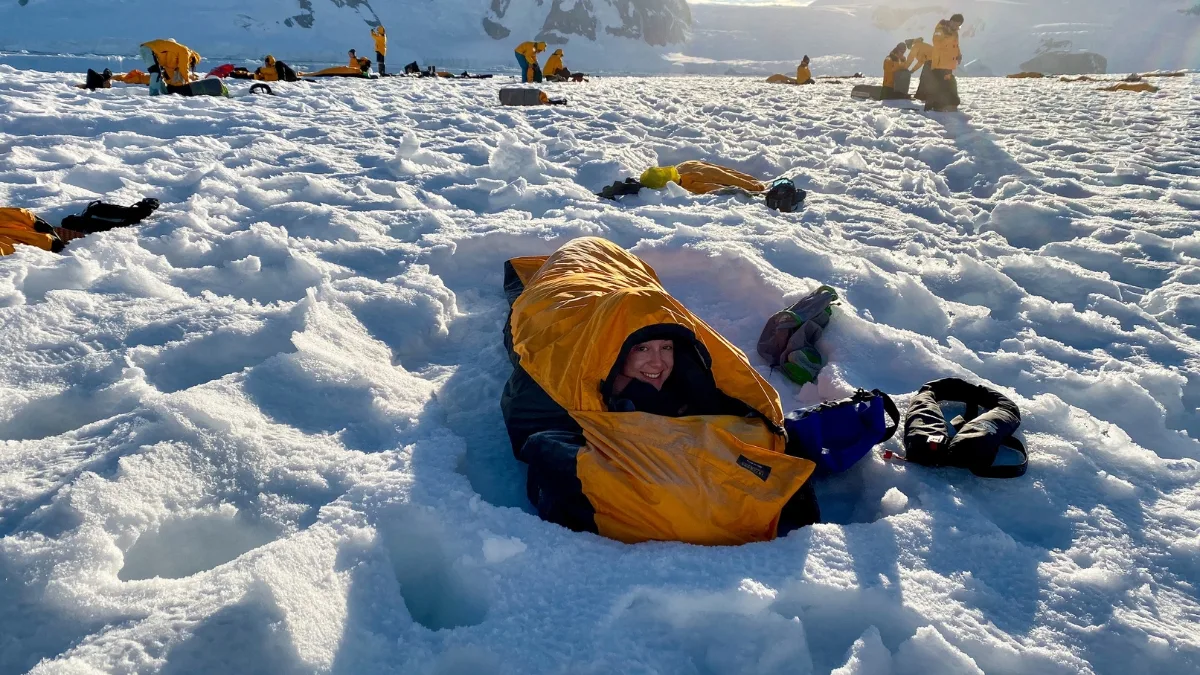
Packing the right gear and clothing is essential for a comfortable and successful trek to Everest Base Camp in winter. In the winter months, the temperatures often drop below freezing with constant snowfall and strong winds. Therefore, it demands proper layering and equipment to stay warm and protected.
Having said that, you should not make the common mistake of overpacking for the trek. Carrying too much weight can add unnecessary burden to your body and make the trek more strenuous. So, stick to the essentials and layer smartly to save extra space in your backpack.
Here is a comprehensive packing list tailored for winter conditions in the Everest region:
Clothing
- Breathable Trekking Shirt
- Trekking Trousers/Leggings
- Thermal Baselayer
- Soft-Shell or Fleece Jacket
- Insulated Down Jacket
- Waterproof Shell Jacket
- Waterproof Trouser
- Breathable Underwear
Footwears
- Ankle-High Hiking Boots
- Sandals or Trainers
- Hiking Socks
- Thermal Socks
- Leg Gaiter
Head Gear
- Sun Protection Hat/Cap
- Beanie
- Buff/Neck Gaiter
- UV Protection Sunglasses
- Headlamp (with Spare Batteries)
Hand Wear
-
Woolen Gloves
- Merino Glove Liners
- Hard-Shell Outer Gloves
Trekking Equipment
- Duffel Bag
- Day Pack (40 to 50L)
- Four-Season Sleeping Bag
- Fleece Sleeping Liner
- Crampons or Microspikes
- Collapsible Trekking Poles
- Thermosets
- Filtered Water Bottle
Toiletries
- Microfibre Towels
- Toilet Papers
- Biodegradable Wet Wipes
- Hand Sanitizer and Soap
- Sunscreen and Moisturizer
- Deodorants or Roll-Ons
- Lip Balm
Tech Kits
- Phone and Camera
- Charging Cables
- Universal Adaptor
- High-Capacity Powerbank
First Aid Kits
- Water Purification Tablets or Drops
- Anti-Diarrhoea Tablets
- Antibiotics (as prescribed by GP)
- Anti-inflammatory Tablets
- Electrolyte Powder or Tablets
- Painkillers and Paracetamol
- Throat Lozenges
- Blister Plasters
- Diamox
- Personal Medications (if any)
Documents
- Passport
- Travel Insurance
- Trekking Permits
- Cash
- Copies of Passport-Sized Photos
Nepal Gateway Trekking have prepared equipment checklist for the trekkers.
Conclusion
Let’s be honest! Trekking to Everest Base Camp in winter is not for everyone. The extreme cold and challenging conditions require meticulous planning, preparation, and proper gear. For those willing to brave the cold and harsh weather, winter reveals a side of the Everest region that only a few seasoned trekkers get to experience.
It offers quieter trails, stunning mountain views, snow-covered landscapes, and a more intimate connection with the locals. Book your trek with Nepal Gateway Trekking for Everest journey.


